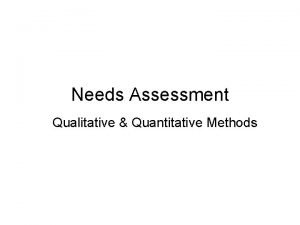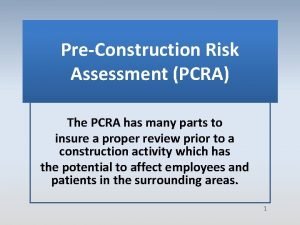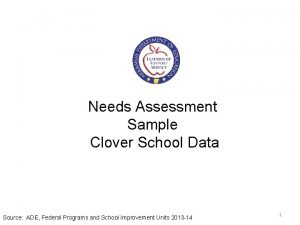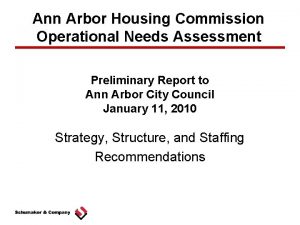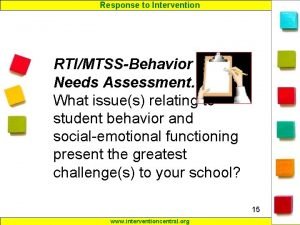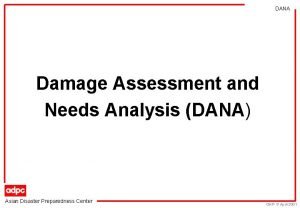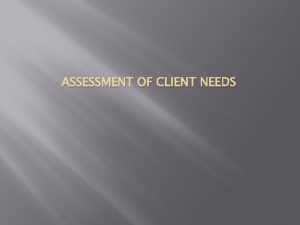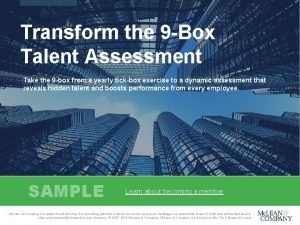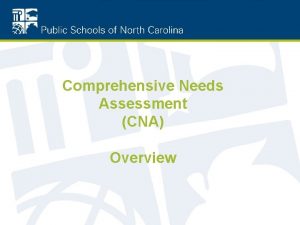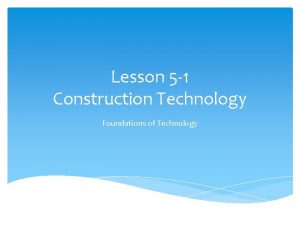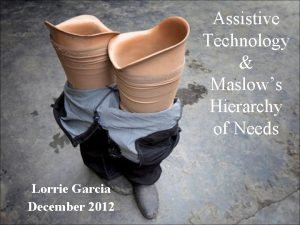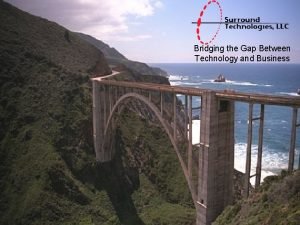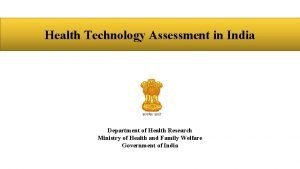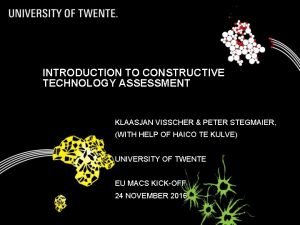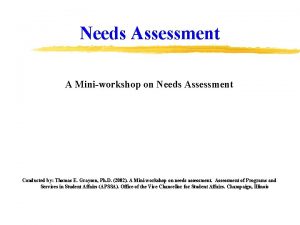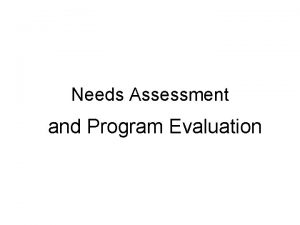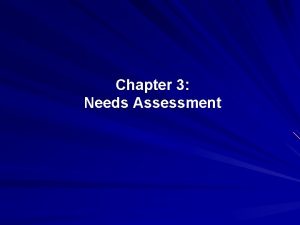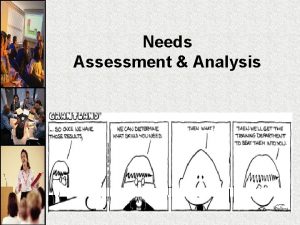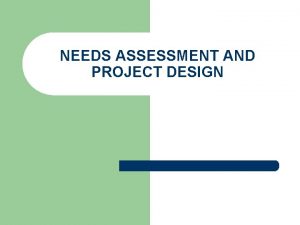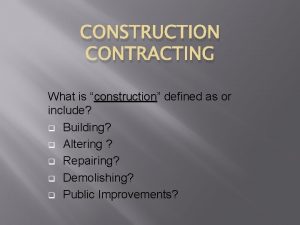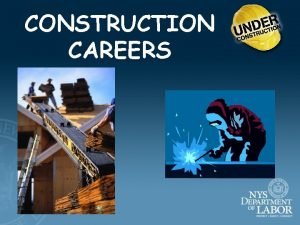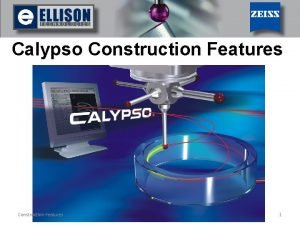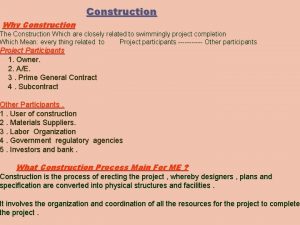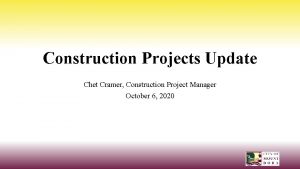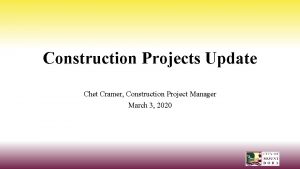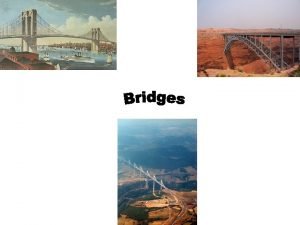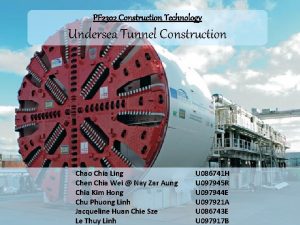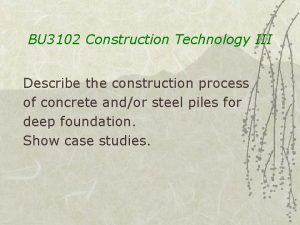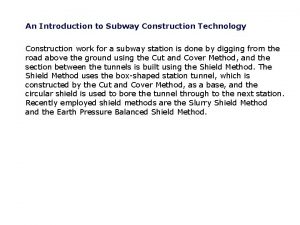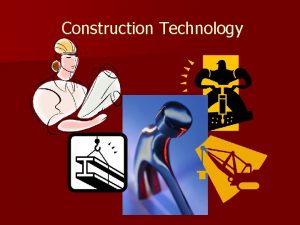Construction Technology Needs Assessment Update Technology Needs Research










































- Slides: 42

Construction Technology Needs Assessment Update Technology Needs Research Team Gareth Williams, Chair

Technology Needs Assessment Bob Chesi U. S. Army Corps of Engineers Willy Fecht Phillips Petroleum Rob Powers BE&K Engineering Co. Mike Vorster Virginia Tech Gary Williams Bechtel, Chair Past members Frank Beddings SMS Demag Edgar Hanley U. S. Department of State Carl Kersten Naval Facilities Engineering Command Kirk Morrow BE&K Engineering Co. Jim Torburg Cherne Contracting Corp.

Mission • Identify areas of the construction industry that: – can be improved by technology. – provide the best payback. • Focus on field operations, not engineering, procurement, or business operations.

Background and History • In 1982 and 1992, CII took snapshots in time. • The studies focused on disciplines and industries. • Recommendations for technology improvements were noted in: – Structural steel erection – Electrical fabrication and installation – Piping fabrication and erection

There Were Nagging Concerns

The Research Got Us Thinking

Our Approach • Research highlights • Review the team’s model of how technology is implemented – Standard processes – Barriers – Enablers

The Research • Focused on operational activities • Analyzed differences in perceptions • Explored technology barriers and enablers

Operational Activities • Personnel management • Tasks and work performance • Onsite information flow • Field materials management • Layout and position control • Reforming, improving, or dramatically changing existing operations • Short-term task and work assignment planning and optimization

Alternate Views • CII member companies — senior management • Superintendents and construction supervisors

Operational Importance Results 1. 00 1 2 3 4 0. 50 0. 00 0. 50 1. 00 Technology Improvement Potential Senior Management Craft Supervision

Onsite Information Flow Operational Importance 1. 00 Providing drawings, specifications and other work management information to the labor at the work site. 0. 50 0. 00 0. 50 1. 00 Technology Improvement Potential Senior Management Craft Supervision

Field Materials Management Operational Importance 1. 00 Tracking, locating, finding, and distributing the right material to right location at the right time. 0. 50 0. 00 0. 50 1. 00 Technology Improvement Potential Senior Management Craft Supervision

Task & Work Performance Operational Importance 1. 00 Training and developing skills in work assignments to improve production, cost quality and safety. 0. 50 0. 00 0. 50 1. 00 Technology Improvement Potential Senior Management Craft Supervision

Changing Existing Operations Operational Importance 1. 00 Improving the production, cost quality, and safety of operations within the scope of your craft(s) through a dramatic change in current methods. 0. 50 0. 00 0. 50 1. 00 Technology Improvement Potential Senior Management Craft Supervision

Personnel Management Operational Importance 1. 00 Keeping a record of and tracking the skills, availability, training, and location of craft labor. 0. 50 0. 00 0. 50 1. 00 Technology Improvement Potential Senior Management Craft Supervision

Layout and Position Control Operational Importance 1. 00 Providing survey information to set out and control the location, position, and alignment of work done. 0. 50 0. 00 0. 50 1. 00 Technology Improvement Potential Senior Management Craft Supervision

Improving Existing Conditions Operational Importance 1. 00 Improving the production, cost quality, and safety of field operations within the scope of your craft(s) with little change in current methods. 0. 50 0. 00 0. 50 1. 00 Technology Improvement Potential Senior Management Craft Supervision

Summary of Results • Unanimous agreement that technology developments will add significant value: – Onsite information flow – providing drawings, specifications and other work management information to the labor at the work site. – Field material management – tracking, finding and distributing the right material to the right location at the right time.

Barriers & Enablers Identified perceived barriers and factors necessary for implementation

Attributes for Implementation Clear and positive benefit-to-cost Effective training under field conditions Able to augment shortage of skills Robust and reliable Able to produce more work with fewer people Supplier support and service Able to improve safety Acceptance of process and work product

Attributes for Implementation Mgmt Clear and positive benefit-to-cost ratio Supv. 1. 3. 4. 5. 6. 7. 8. 2.

Attributes for Implementation Mgmt More work, fewer people 1. Supv. 1. 2. 3. 4. 5. 6. 7. 8.

Attributes for Implementation Mgmt 1. Ability to improve safety 2. Supv. 1. 2. 3. 4. 5. 6. 7. 8.

Attributes for Implementation Mgmt 1. Effective training in field conditions Supv. 1. 2. 3. 4. 5. 6. 7. 8.

Attributes for Implementation Mgmt Robust & reliable to operate Supv. 1. 2. 3. 4. 5. 6. 7. 8.

Summary of Results • Unanimous agreement on the most important enabler for new technology: Clear and positive benefit to cost ratio • Also important is: – Ability to do more work with less people – Ability to improve safety – Effective training and use in field conditions

Lessons • Inconsistent understanding of what is needed and important. • Many people involved with different needs and viewpoints and drivers. • Poor follow-through.

General Consensus “The path to general implementation of a great idea and technology solution is long and tortuous. ”

General Consensus “The construction industry is decades behind in taking advantage of new technology. ”

The Process • The needs assessments have been a “batch process” to date. • We need a continuous, market- driven process in the future.

The Technology Implementation Cycle Solutions Needs

The Technology Implementation Cycle Solutions Needs

The Technology Implementation Cycle Solutions Needs

The Technology Implementation Cycle Solutions Needs

The Technology Implementation Cycle Solutions Needs

The Technology Implementation Cycle Solutions Needs

The Technology Implementation Cycle Solutions Needs

An Issue for Decades • Technology needs assessment teams • Fully integrated automated project processes (FIAPP) • FIATECH • CII’s Breakthrough Strategy Committee • Teams dedicated to studying specific technology tools

The Technology Implementation Cycle Solutions Needs

The Technology Implementation Cycle

The Implementation Session • Hand out the pamphlet • Details of the technology implementation cycle • Case studies of successful technological solutions: – Hilti fastening systems – Laser-scanned as-builts – GPS Bulk Material Tracking System
 ........ is an alternative of log based recovery.
........ is an alternative of log based recovery. Assessment is qualitative or quantitative
Assessment is qualitative or quantitative Primary needs and secondary needs
Primary needs and secondary needs Primary needs and secondary needs
Primary needs and secondary needs Henry murray theory
Henry murray theory Strategic gender needs and practical gender needs
Strategic gender needs and practical gender needs What is need analysis in esp
What is need analysis in esp Pcra risk assessment
Pcra risk assessment Adult needs and strengths assessment
Adult needs and strengths assessment Ade needs assessment
Ade needs assessment Community needs assessment steps
Community needs assessment steps Challenges of needs assessment
Challenges of needs assessment Ann arbor housing commission
Ann arbor housing commission Mtss needs assessment
Mtss needs assessment Pamela schwartz
Pamela schwartz Transportation needs assessment
Transportation needs assessment Dana asian
Dana asian Client needs assessment
Client needs assessment Tyler model of curriculum development
Tyler model of curriculum development 9 box talent assessment
9 box talent assessment Comprehensive needs assessment
Comprehensive needs assessment Comprehensive local needs assessment
Comprehensive local needs assessment Health needs assessment
Health needs assessment Needs assessment template
Needs assessment template Scot theory examples
Scot theory examples Social construction of technology
Social construction of technology Green road construction technology
Green road construction technology Foundation in construction technology
Foundation in construction technology Construction communication technology
Construction communication technology European construction technology platform
European construction technology platform Maslow's hierarchy of needs technology
Maslow's hierarchy of needs technology Bridging the gap between technology and business needs
Bridging the gap between technology and business needs Essential elements of portfolio assessment
Essential elements of portfolio assessment Define dynamic assessment
Define dynamic assessment Portfolio assessment matches assessment to teaching
Portfolio assessment matches assessment to teaching It assessment
It assessment Health technology assessment france
Health technology assessment france Health technology assessment india
Health technology assessment india Technology readiness assessment template
Technology readiness assessment template Klaasjan visscher
Klaasjan visscher Zechariah
Zechariah What are these
What are these University community plan update
University community plan update

